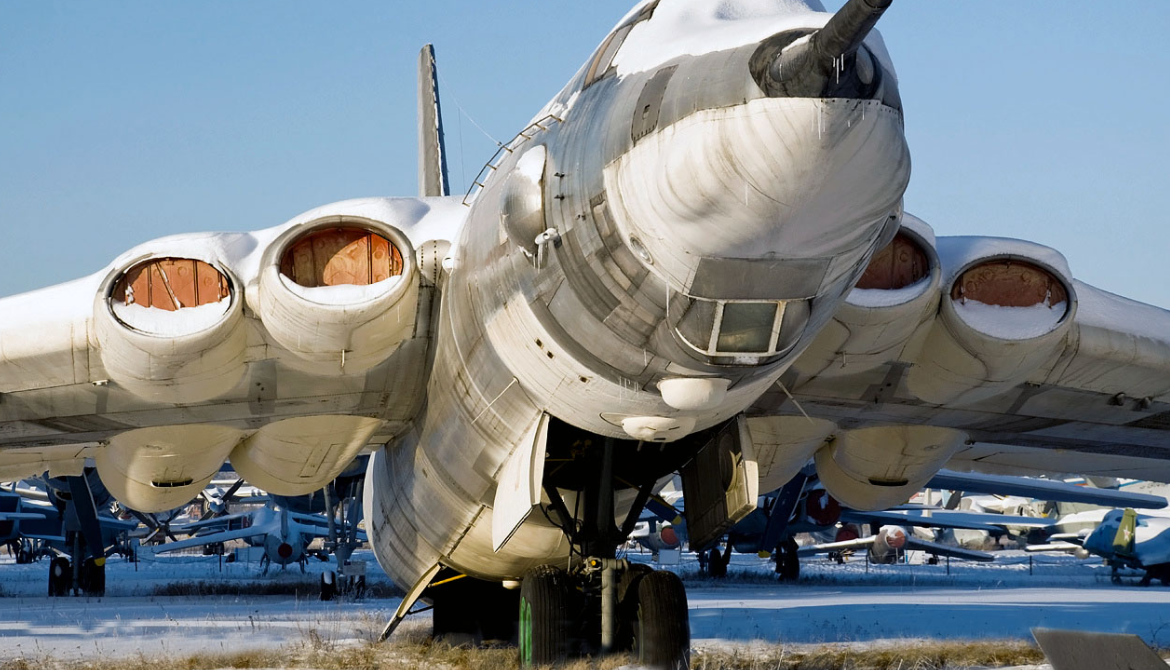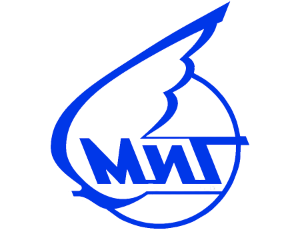Myasishchev M-4 Molot "Bison"
 |
|
| Myasishchev 3MD at Monino Central Air Force Museum (Moscow) | |
| Role | Strategic bomber |
|---|---|
| National origin | Soviet Union |
| Manufacturer | Myasishchev |
| First flight | 20 January 1953 (M-4/2M)1956 (M-6/3M) |
| Introduction | 1956 (M-4/2M)1958 (M-6/3M) |
| Retired | 1994 |
| Primary users | Soviet Air Force Soviet Navy Russian Air Force |
| Produced | 125 |
| Number built | 2 prototypes, 123 |
| Variants | Myasishchev VM-T |
|
|
.
History V. M. Myasishchev Experimental Design Bureau
Myasishchev M-4 Molot
NATO reporting name "Bison"

The Myasishchev M-4 Molot (Russian: Молот (Hammer), USAF/DoD reporting name "Type 37", ASCC reporting name Bison) was a four-engined strategic bomber designed by Vladimir Mikhailovich Myasishchev and manufactured by the Soviet Union in the 1950s to provide a Long Range Aviation bomber capable of attacking targets in North America
Design and development
Following World War II, the Soviet Union prioritized developing a long-range strategic bomber capable of delivering atomic weapons. Their first aircraft was the Tupolev Tu-4, a reverse-engineered version of the American B-29 Superfortress.
Variants


- Izdeliye M (Product M) – the in-house designation for the SDB, Project 25, M-4 aircraft.
- SDB (Strategichesky Dalny Bombardirovshchik – strategic long-range bomber) – The government designation for the M-4 programme.
- [Tema Dvadtsat Pyat] Subject 25 – The VVS designation for the strategic bomber program.
- Myasishchev 3M-5 – The improved M-4 with Dobrynin VD-7 engines with higher thrust and better S.F.C. than the Mikulin AM-3A engines, configured as a launch platform for the KSR-5 air to surface missile. One prototype aircraft converted from a 3MN-1 bomber, but further conversions not carried out due to the limited life remaining on candidate aircraft. (NATO Bison-B)
- Myasishchev 3ME – A comprehensive avionics upgrade was tested on the sole 3ME, converted from a production 3M bomber (c/n 8301101). New navigation and radar equipment and a completely revised fire sensing and suppression system were also fitted. The prototype was damaged beyond repair when the Myasishchev M-50 prototype jumped its chocks during ground running of the engines, striking the 3ME killing one engineer on the 3ME. (NATO Bison-B)
- 101M - M-4 prototype.1 machines manufactured.
- 102M - This is an M-4 ground strength tester not intended for flight. 1 machine manufactured.
0
KmCeiling
0
KmCombat RANGE
0
Km/hAircraft Speed
0
Max Crew
Photo Gallery
V. M. Myasishchev Experimental Design Bureau
Myasishchev M-4 Molot NATO reporting name "Bison"


V. M. Myasishchev Experimental Design Bureau
Myasishchev M-4 Molot NATO reporting name "Bison"
General Info
-
-
-
- Crew: 8
- Length: 47.2 m (154 ft 10 in)
- Wingspan: 50.5 m (165 ft 8 in)
- Height: 14.1 m (46 ft 3 in)
-
-
Powerplant
-
-
-
- Empty weight: 79,700 kg
- Gross weight: 138,500 kg
- Max takeoff weight:181,500 kg
- Powerplant: 4 × Mikulin AM-3A turbojets, 85.75 kN (19,280 lbf) thrust each
-
-
Performance
- Maximum speed: 947 km/h
- Range: 5,600 km
- Ferry range: 8,100 km
- Service ceiling: 11,000 m
Armament
-
- Guns: 9 × 23 mm NR-23 cannon or 6 × 23 mm AM-23 cannon in ventral, dorsal and tail barbettes. 1,100 rounds in ventral and dorsal barbettes, 2,000 rounds in tail barbette.
- Missiles: Up to four cruise missiles carried externally.
- Bombs: Typically 12,000 kilograms
-
.
Links to Youtube & Others
The new airplane was not for the Soviet Air Force (VVS), but rather for the Naval Aviation (AV-MF). Though it could still not bomb Washington, D.C., the 3M had a sufficient range to fulfill the need for a long-range maritime patrol aircraft. In 1959, the 3M broke numerous world records for payload to height, including 10,000 kilograms.
V. M. Myasishchev Myasishchev M-4 Molot
M-4s and 3Ms were primarily used as long-range maritime reconnaissance and strike aircraft and other supporting roles.
Youtube Link
The design was updated with more efficient engines, inflight refuelling (IFR) support and the removal of the glass nose for optical bombing and moving the radar to this location.









.png)



